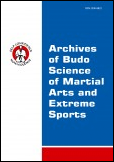2016, Volume 12, Issue 1
Effects of a Brazilian jiu-jitsu training session on physiological, biochemical, hormonal and perceptive responses
Braulio Henrique Magnani Branco1, Leonardo Vidal Andreato2, Anselmo Alexandre Mendes3, Gustavo Renan Gilio3, Alexandro Andrade2, Nelson Nardo Júnior4
1Physical Education, UNICESUMAR - University Center of Maringá, Maringá, Paraná, Brazil, Brazil
2Physical Education, UDESC, Florianópolis, Santa Catarina, Brazil, Brazil
3Physical Education, UEM, Maringá, Paraná, Brazil, Brazil
4UNICESUMAR - University Center of Maringá, Physical Education, Maringá, Paraná, Brazil
Author for correspondence: Braulio Henrique Magnani Branco; Physical Education, UNICESUMAR - University Center of Maringá, Maringá, Paraná, Brazil, Brazil; email: brauliomagnani[at]live.com
Full text
Abstract
Background & Study Aim: Brazilian jiu-jitsu (BJJ) training consists of actions performed from vertical posture (throws) and from ground positions (groundwork), including strangulation, joint lock techniques (wrist, arm, ankle, knee and leg), knee on belly, and immobilisation manoeuvres There were two objectives of these studies: the effect of a Brazilian jiu-jitsu training session on physiological, biochemical, hormonal, and perceptive responses: the rating of perceived exertion (RPE) in relation to physiological effects, cellular damage, and hormone levels generated by training.
Material & Methods: Fourteen male-adult Brazilian jiu-jitsu athletes participated in a training session lasting 1h30min and consisting of six matches. Before, immediately after, and post 24h, venous blood samples were collected to measure cellular damage and hormonal levels. During the training, blood lactate (La), heart rate (HR), the RPE (6-20 scale for matches and 0-10 scale, thirty minutes after session), and local fatigue were measured.
Results: Results showed that the levels of cortisol, testosterone/cortisol ratio, creatine kinase (CK), aspartate (AST) and alanine (ALT) aminotransferase remained high at least until post 24h (p<0.01). There was a post-training increase of lactate dehydrogenase (LDH) (p<0.001), but this returned to baseline post 24h. By the fourth match correlations were observable between (La) and HR (r = 0.48; p<0.05) and between RPE6-20 and HR (r = 0.66; p<0.01). Also, observed immediately after training was a correlation between the internal training load and delta of ALT (r = 0.66; p<0.01) and LDH (r = 0.50; p<0.01).
Conclusions: This type of training increases the catabolic state and generates cell damage that fails to return to basal levels even post 24h. The study also found that RPE6-20 is not very effective for predicting intensity throughout the training (matches performed), which suggests that perceptive scales should be used with caution.
Key words: matches performed, combat sports, cellular damage, training control, training load





